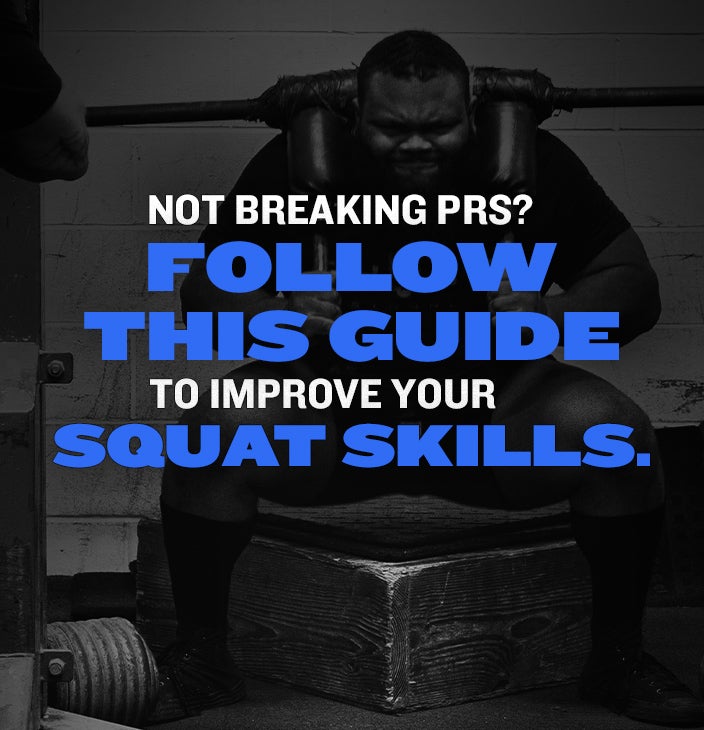WSBB Blog: 3 Max Effort Movements to Improve Your Squat Skills

If you are looking for one lift you can improve to help you become a better athlete, look no further than the squat. No matter what sport you compete in, every athlete needs to have a strong squat. For the conventional athlete, squatting leads to increases in speed, agility, strength, and explosive power. For the strength sports athlete, squatting a heavy barbell is necessary to become competitive. It will also supply the strength sports athlete with the same benefits in athletic performance afforded to the conventional athlete.
To become skilled at the squat, you must program your max effort lower workouts correctly. Many believe that you must squat multiple rep sets to gain athletic benefits from the squat; however, this is not the case. Squatting for multiple sets and reps will increase your lower body strength endurance and provide you with the volume needed to add muscle mass. However, you must utilize special max effort lower exercises to enhance your lower body strength and coordination.
The question then becomes, which exercise variations should an athlete implement into their max effort lower training to build a stronger squat and become more skilled in the movement. Below, we will go over the max effort lower exercises we use at Westside Barbell to increase lower body absolute strength, solve movement issues, and increase an athlete's squat skill.
Giant Cambered Bar Squat vs. Chain
As anyone who has used the giant cambered bar will tell you, this bar greatly emphasizes the posterior chain muscles responsible for squatting and deadlifting. If you want to develop a bulletproof mid and low back while building hamstrings that are as strong as cables, the giant cambered bar is the barbell for you.
By adding chains to the barbell, you are enhancing the giant cambered bar training effect even further. The giant cambered bar forces the lifter to engage the trunk and back muscles properly, along with the glutes and hamstrings, to remain upright due to the sway of the barbell. Lifters often report feeling like the bar is "dragging" them forward.
This effect is enhanced even further with chain added, leading to increased gains in lower body absolute strength. This exercise is for you if you have issues with your hips rising too fast out of the hole or struggle to keep a solid trunk brace while squatting.
SSB Squat vs. Forward Pulling Minibands
This exercise is specifically for those lifters who struggle to properly unrack and maintain proper upper back posture in the squat. The safety squat bar places the barbell in a high bar position, which right away is going to put a great demand on the upper and mid-back. By adding in the forward pulling minibands, this training effect is enhanced even further, creating a problem for the lifter that can only be solved by adequately bracing and flawlessly executing the squat.
As you can imagine, the bands try to pull your chest down throughout the entirety of the lift. Right from unrack, you will immediately feel the increased demand placed upon the upper back by the forward pulling minibands. This will force you to create as much abdominal pressure as possible to brace against the pull of the bands. Not only will you become stronger from this increased need for proper bracing, but you will also become more skilled at unracking and stabilizing the barbell.
Suppose you find yourself letting your upper body slouch when unracking a heavy barbell, or you struggle with remaining stable after unracking a heavy barbell. In that case, this is the exercise for you.
Giant Cambered Bar Goodmornings vs. Forward Pulling Minibands
Going back to the giant cambered bar, this exercise is the ideal movement to use when you have issues dropping your chest in the squat. When we refer to "dropping the chest," we are referring to when a lifter allows their upper and mid back to lose stability, forcing a majority of the barbell weight onto the front of the feet, inevitably leading to a missed lift.
As we mentioned above, the giant cambered bar is a bar that will try its best to move the lifter out of position. Specifically, this bar is typically trying to drag you forward. Adding in the forward pulling minibands further increases this forward drag, requiring you to maintain a solid brace, using the upper, mid, and low back, along with the hamstrings to complete the lift successfully.
The idea behind using this setup for goodmornings is simple: If you can manage to lift heavy goodmornings using a giant cambered bar with forward bands attached, you will be able to prevent a regular squat bar from collapsing your chest and placing you in a disadvantageous position. If you are a lifter who constantly experiences chest collapse during the concentric phase of the squat, this is the exercise for you.
Works Sourced:
Supertraining; by Dr. Mel Siff
Westside Barbell Book of Methods; by Louie Simmons
Special Strengths Development for All Sports; by Louie Simmons
Tags: Squat, Weakness, Lower Body Training




